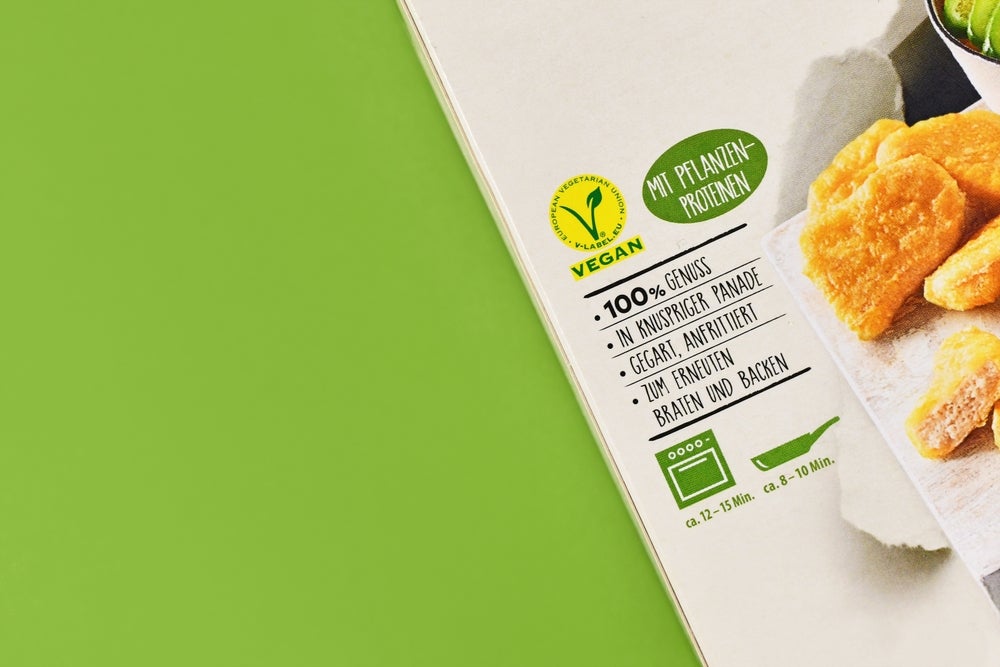
As we inch closer to 2024, trend forecasts point to plant-based eating as a cornerstone of the modern diet.
More than 1,610 new vegan products and menus were launched in 2023 alone and overall, studies found consumers are looking for simpler, less processed foods that lean into value and sustainability.
As Veganuary approaches, businesses must maintain the highest standards, attract wider demographics and keep products safe for consumers.
Regulation requirements
Vegan businesses should prioritise materials that have been certified by reputable organizations and ensure materials and processes meet the specific USDA requirements to be eligible for vegan labelling.
This also means companies must take precautions to prevent cross-contamination with animal-derived ingredients during processing, especially in shared facilities or equipment used for both vegan and non-vegan products.
Packaging experts must exercise caution, when selecting adhesives for laminates or sealing cartons in the context of vegan products. Adhesives used for carton sealing in vegan products should unequivocally steer clear of gluten, bone glue, and casein derived from animal byproducts.
Other components involved in packaging, including lacquers, coatings, inks, dyes, and additives intended to bolster performance or longevity, are also a matter of concern for some individuals seeking vegan-friendly packaging solutions.
While not mandatory, businesses can help put consumers at ease, by obtaining certifications from recognized vegan organizations, which can enhance credibility.
Certifications like the Vegan Society’s Vegan Trademark, Certified Vegan by Vegan Action, or the European Vegetarian Union’s Vegan Flower label can help assure consumers that the product meets vegan standards, and they won’t expect any of the potential issues listed above.
The correct materials for vegan packaging
To be a manufacturer of vegan packaging it all starts with carefully choosing the right suppliers and materials. There are several options suitable for vegan food items, which align with both ethical and practical considerations.
Attaining materials from vegan verified suppliers, is an excellent starting point, as it ensures there are no animal derived ingredients used in packaging manufacturing like animal-based glues or certain dyes that may contain animal byproducts.
Source options like compostable plastics, paper, and plant-based fibres that can break down naturally without harmful residues. When possible, choose glass or metal containers that are highly recyclable and inert, minimising chemical interactions with the packaged product.
Tupperware-style containers or reusable pouches made from silicone or other food-grade materials offer a sustainable option for packaging vegan foods, especially for products intended for multiple servings.
Labelling, traceability, and transparency
Precise and comprehensive labeling of vegan food products holds the potential to boost food sales significantly by eradicating potential confusion for consumers.
Businesses are strongly advised to incorporate detailed and precise labels on their products, ensuring compliance with essential legal requirements. Among these requirements, including a “use by” or “best before” date on food and beverage items stands as a crucial obligation.
Clearly labelling that your product is suitable for vegans is key, as most consumers will skip steps like contacting the manufacturer and err on the side of caution by buying a product with better labelling if unsure. To make this claim, you must ensure that all ingredients are plant-based and do not contain any animal-derived components. This includes additives, flavors, colors, and processing aids.
Try to avoid any ambiguity in a label’s claims. For example, ‘Dairy-free’ or ‘lactose-free’ doesn’t necessarily mean vegan. Other ingredients like Glycerin(e)/glycerol and stearic acid can be derived from slaughterhouse fat – but they could also be vegan – so if they are plant-derived then it should say so on the label.
Labels should also clearly highlight any allergens present in the product, such as nuts, soy, wheat, or gluten. Even if the product is vegan, it might contain allergens, and their presence should be clearly stated.
You should provide guidance on how to store the product properly, whether it needs refrigeration, and any specific storage conditions to maintain its quality. Include a barcode for scanning at the point of sale and a batch or production code for traceability and quality control purposes.
Use packaging to build your brand
From plant milks and meat substitutes, to cheeses and chocolate, the key to today’s most successful vegan branding is personality-driven packaging.
Popular plant-based brand Oatly’s design is the prime example. Designed to be witty and often tongue-in-cheek, Oatly’s packaging directly opposes the “preachy vegan” stereotype.
Many vegan brands are working hard to develop mainstream appeal, as well as attracting their usual vegan audience. One of the ways many are doing this is by ditching traditional vegan images and descriptions on their packaging completely.
Research demonstrates that appealing packaging triggers activity in brain regions linked to feelings of reward, whereas unappealing packaging stimulates areas associated with negative emotions. This shows packaging alone can significantly impact our emotional responses and influence our purchasing decisions.
This can be reflected in the changes to vegan packaging over the years. For example, many aren’t using greens and browns and muted colours anymore, they are no longer trying to appear ‘natural’ or ‘rustic’.
Instead, they want their products to be as Instagrammable as possible and they are using their packaging to do this, with striking visuals and a more unique color palette.
Packaging is also being used to accentuate vegan brand messaging and we’re seeing a rise in vegan brands promoting the taste, pleasure and enjoyment that comes from a product over its ethical status or health benefits.
It’s a clever move, as by avoiding traditional associations of veganism, brands don’t risk alienating other potential markets. By further emphasizing these details on their packaging, vegan brands are creating yet another way to connect with a broader audience.
It’s clear that as we progress into an era characterised by conscientious consumption, sustainability, regulatory compliance, and innovative branding will undoubtedly continue to shape the narrative of the burgeoning plant-based market in 2024 and beyond.
About the author: Charles Haverfield is CEO of US Packaging & Wrapping, a full-service, customer-driven packaging supply company.



